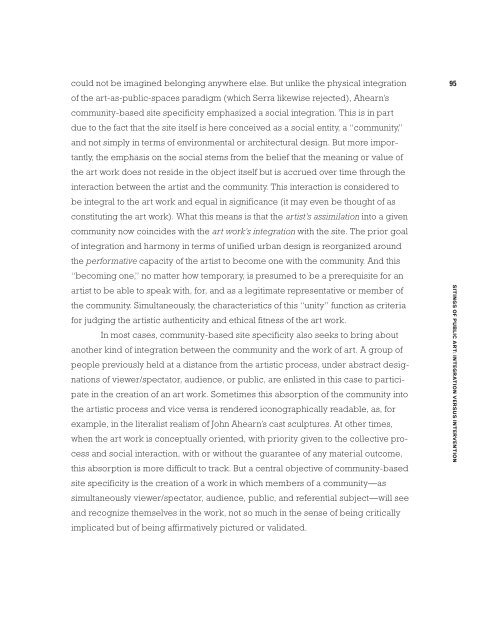ONE PLACE AFTER ANOTHER - Monoskop
ONE PLACE AFTER ANOTHER - Monoskop
ONE PLACE AFTER ANOTHER - Monoskop
You also want an ePaper? Increase the reach of your titles
YUMPU automatically turns print PDFs into web optimized ePapers that Google loves.
could not be imagined belonging anywhere else. But unlike the physical integration<br />
of the art-as-public-spaces paradigm (which Serra likewise rejected), Ahearn’s<br />
community-based site specificity emphasized a social integration. This is in part<br />
due to the fact that the site itself is here conceived as a social entity, a “community,”<br />
and not simply in terms of environmental or architectural design. But more importantly,<br />
the emphasis on the social stems from the belief that the meaning or value of<br />
the art work does not reside in the object itself but is accrued over time through the<br />
interaction between the artist and the community. This interaction is considered to<br />
be integral to the art work and equal in significance (it may even be thought of as<br />
constituting the art work). What this means is that the artist’s assimilation into a given<br />
community now coincides with the art work’s integration with the site. The prior goal<br />
of integration and harmony in terms of unified urban design is reorganized around<br />
the performative capacity of the artist to become one with the community. And this<br />
“becoming one,” no matter how temporary, is presumed to be a prerequisite for an<br />
artist to be able to speak with, for, and as a legitimate representative or member of<br />
the community. Simultaneously, the characteristics of this “unity” function as criteria<br />
for judging the artistic authenticity and ethical fitness of the art work.<br />
In most cases, community-based site specificity also seeks to bring about<br />
another kind of integration between the community and the work of art. A group of<br />
people previously held at a distance from the artistic process, under abstract designations<br />
of viewer/spectator, audience, or public, are enlisted in this case to participate<br />
in the creation of an art work. Sometimes this absorption of the community into<br />
the artistic process and vice versa is rendered iconographically readable, as, for<br />
example, in the literalist realism of John Ahearn’s cast sculptures. At other times,<br />
when the art work is conceptually oriented, with priority given to the collective process<br />
and social interaction, with or without the guarantee of any material outcome,<br />
this absorption is more difficult to track. But a central objective of community-based<br />
site specificity is the creation of a work in which members of a community—as<br />
simultaneously viewer/spectator, audience, public, and referential subject—will see<br />
and recognize themselves in the work, not so much in the sense of being critically<br />
implicated but of being affirmatively pictured or validated.<br />
95<br />
SITINGS OF PUBLIC ART: INTEGRATION VERSUS INTERVENTION

















